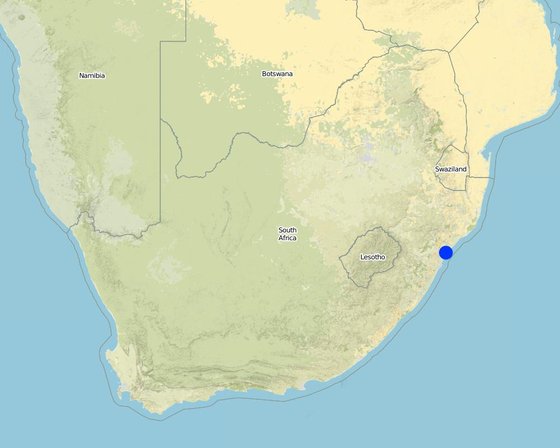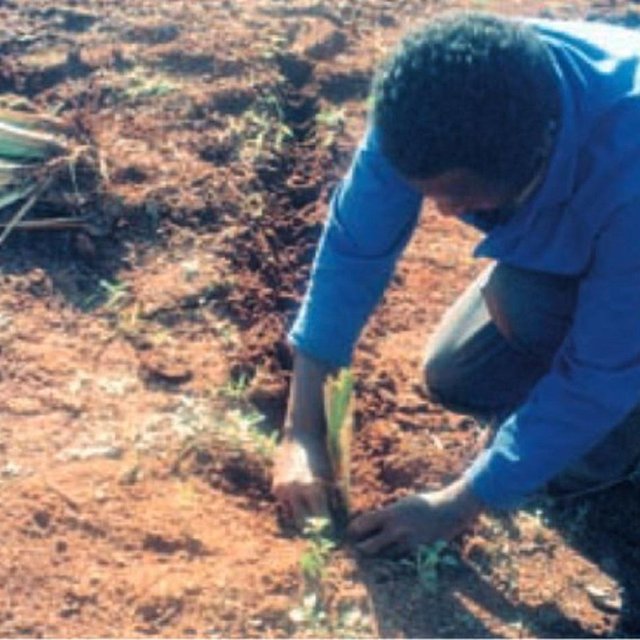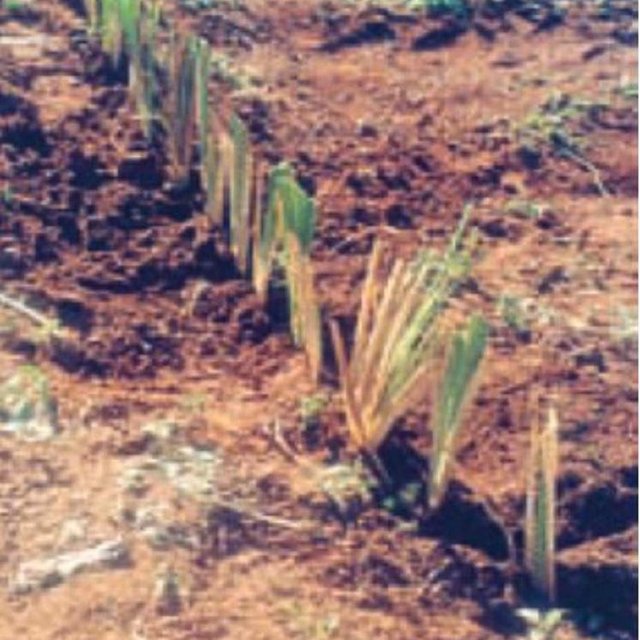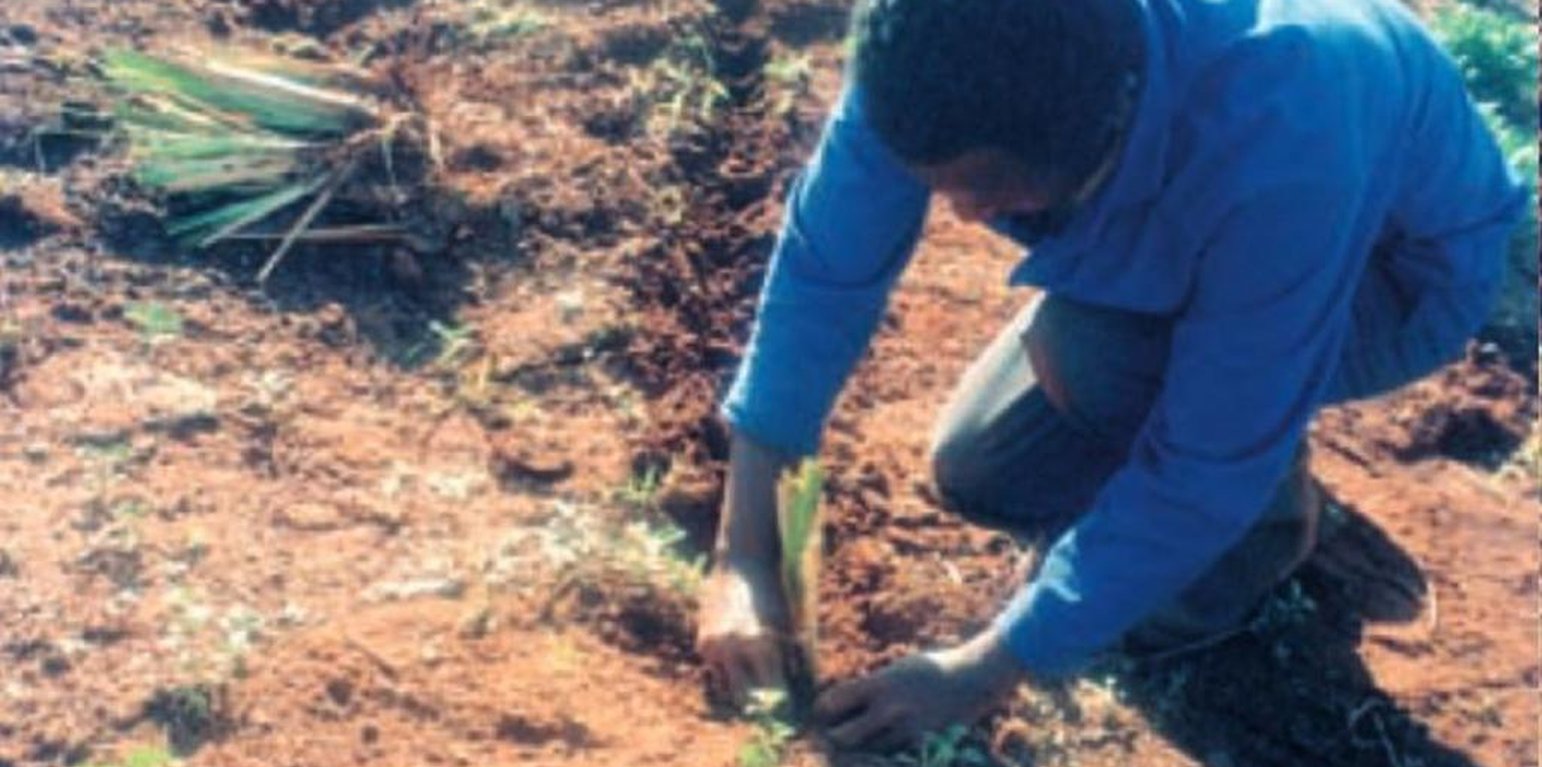Self teaching
(ЮАР)
Описание
Learning how to use vetiver grass as a vegetative conservation barrier through instructions from a booklet and hands-on practical experience.
Aims / objectives: The manager of the farm was given a book and video on vetiver grass by the Mazda group from UK. His objective was to teach himself to improve his conservation system. Already he had a number of consercation strategies, including terracing, minimum tillage, mulching and strip-cropping, but he felt there was a need to better his syste,. Through self-teaching he gave himself an oppurtunity to do so.
There had been some vetiver plants on the farm for 40 years, and it held the soil in place where it grew. This vetiver grew into huge clumps comprising many splits (tillers). The book demonstrated how vetiver could be dug up, split and planted in a continuous barrier hedge for soil and water conservation. In other words, the book offered the possibility of improving on what was already there.
The approach therefore was to take ideas from a book, testing those ideas and see how they worked in practice. The approach has developed further by the farmer spreading his message to neighbours, some of whom have copied the system after visiting his farm and seeing the results for themselves. While the original handbook had been aimed especially at Indian farmers, subsequent to the successful experience of this particular farmer, a locally focussed handbook has been recently prepared in English and Zulu by the South African Vetiver Network.
Местоположение

Местоположение: Lower Tugela District, South Africa, Kwa-Zulu Natal, ЮАР
Географическая привязка выбранных участков
Дата ввода в действие: 1989
Дата завершения: н/п
Тип Подхода
-
традиционная/ местная система землепользования, используемая коренным населением
-
недавняя местная инициатива/ инновация
-
в рамках проекта/ программы

Slips of vetiver grass are planted according to instructions in the booklet (William Critchley)

Spacing between slips is 10–15 cm apart at the time of planting. This should form a dense barrier but gapping-up may be necessary in subsequent seasons. (William Critchley)
Цели подхода и благоприятные условия для его реализации
Главные цели/ задачи Подхода
The Approach focused on SLM only
test and try a new method by self-teaching and gaining hands-on experience
The SLM Approach addressed the following problems: lack of knowledge about alternative conservation technologies, need for a new and cheap supplement to existing forms of soil and water conservation within sugar cane, that could be tested and tried by the farmer himself without need for outside advice.
Условия, содействующие применению Технологии/ Технологий в рамках Подхода
-
Нормативно-правовая база (землевладение, права на земле- и водопользование): The existing land ownership, land use rights / water rights greatly helped the approach implementation: Made own decision and started to implement immediately
Условия, затрудняющие применение Технологии/ Технологий в рамках Подхода
-
Наличие/ доступность финансовых ресурсов и услуг: Need to find a cheap supplement to existing SWC in sugar cane
Treatment through the SLM Approach: Discovery of vetiver grass barrier hedge technology described in a booklet
Участие и распределение ролей заинтересованных сторон
Заинтересованные стороны, участвующие в реализации Подхода, и их роли
| Какие заинтересованные стороны/ организации-исполнители участвовали в реализации Подхода? |
Перечислите заинтересованные стороны |
Опишите роли заинтересованных сторон |
| местные землепользователи/ местные сообщества |
Working land users were mainly men (Also women, the men are used for more physical work (harder)) |
|
Участие местных землепользователей/ местных сообществ на разных стадиях реализации Подхода
нет
пассивное
внешняя поддержка
интерактивное
самоорганизация
планирование
reading and thinking through the possibilities
выполнение
paying farm labourers to plant the grass
Схема реализации Подхода
Establishing vetiver hedges: instructions on preparation for planting in the vetiver handbook.

Автор: World Bank, 1990
Принятие решений по выбору Технологии УЗП
Решения принимались
-
исключительно землепользователи (по собственной инициативе)
-
в основном землепользователи при поддержке специалистов по УЗП
-
все участники как часть процесса совместных действий
-
преимущественно специалисты по УЗП после консультаций с землепользователями
-
исключительно специалисты по УЗП
-
политики/ руководители
Принятие решений было основано на
-
анализ подробно описанного опыта и знаний по УЗП (принятие решений на основе подтвержденных фактов)
-
результаты исследований
-
личный опыт и мнения (незадокументированные)
Техническая поддержка, повышение компетенций и управление знаниями
Следующие мероприятия или работы являлись частью Подхода
-
Повышение компетенций/ обучение
-
Консультационные услуги
-
Институциональная (организационная) поддержка
-
Мониторинг и оценка
-
Научные исследования
Повышение компетенций/ обучение
Обучение было предоставлено следующим заинтересованным лицам
-
землепользователи
-
местный персонал/консультанты
Тип обучения
-
в ходе работы
-
обмен опытом между фермерами
-
опытные участки
-
общие собрания
-
курсы
-
self-taught, hands-on experience
Мониторинг и оценка
bio-physical aspects were regular monitored by land users through observations; indicators: vetiver performance
technical aspects were ad hoc monitored by land users through observations
economic / production aspects were ad hoc monitored by land users through observations
area treated aspects were regular monitored by land users through measurements
no. of land users involved aspects were ad hoc monitored by land users through observations
There were no changes in the Approach as a result of monitoring and evaluation
There were no changes in the Technology as a result of monitoring and evaluation
Финансирование и внешняя материальная поддержка
Годовой бюджет мероприятий по УЗП в долларах США
-
< 2000
-
2000-10000
-
10000-100000
-
100 000-1 000 000
-
> 1 000 000
Precise annual budget: н/п
Approach costs were met by the following donors: other (farmer itself): 100.0%
Землепользователям были оказаны/предоставлены следующие услуги или меры стимулирования
-
Финансирование и внешняя материальная поддержка, предоставляемая землепользователям
-
Субсидии на отдельные затраты
-
Кредитование
-
Другие методы или инструменты стимулирования
Анализ влияния и заключительные положения
Влияние Подхода
Нет
Да, немного
Да, умеренно
Да, существенно
Сумел ли Подход помочь землепользователям внедрить и поддерживать технологии УЗП?
Land users can continue without support and at least a modest spontaneous expansion of adoption is expected.
Did other land users / projects adopt the Approach?
Three neighbouring farmers have adopted the technology throught their observations
Основные причины, побуждающие землепользователей внедрять УЗП
Долгосрочная устойчивость мероприятий в рамках Подхода
Могут ли землепользователи самостоятельно (без внешней поддержки) продолжать применение того, что было реализовано в рамках Подхода?
Land users can continue without support and at least a modest spontaneous expansion of adoption is expected.
Заключительные положения и извлечённые уроки
Сильные стороны: по мнению землепользователей
-
Neighbours can easily see and copy (How to sustain/ enhance this strength: Farmer-to-farmer visits could be promoted through self-help groups and associations.)
-
A very cheap method of extension/knowledge transfer (How to sustain/ enhance this strength: Produce and disseminate booklets and information on the internet more widely.)
Сильные стороны: по мнению составителя или ответственных специалистов
-
A technical system devised from a handbook and experience rather than needing a project or intensive visits from extension agents (How to sustain/ enhance this strength: Make sure such handbooks are spread and available in local languages.)
Слабые стороны/ недостатки/ риски: по мнению землепользователейвозможные пути преодоления
Слабые стороны/ недостатки/ риски: по мнению составителя или ответственных специалистоввозможные пути преодоления
-
Not everyone has access to such teaching material or is literate
Spread literature and information more widley and in local languages both in written form and on the radio.
Справочные материалы
Рецензент
-
Fabian Ottiger
-
Deborah Niggli
Продолжительность применения Технологии: 15 января 2009 г.
Последнее обновление: 4 апреля 2018 г.
Ответственные специалисты
-
Philippe Zahner (philippe.zahner@deza.admin.ch) - Специалист по УЗП
-
Rinda van der Merwe (rinda@arc.agric.za) - Специалист по УЗП
Полное описание в базе данных ВОКАТ
Документирование осуществлялось при участии
Организация
- Institute for Soil, Climate & Water - ЮАР
- Swiss Agency for Development and Cooperation (DEZA / COSUDE / DDC / SDC) - Швейцария
Проект
- Book project: where the land is greener - Case Studies and Analysis of Soil and Water Conservation Initiatives Worldwide (where the land is greener)
Ключевые ссылки
-
World Bank (1990): Vetiver Grass: The Hedge against Erosion: World Bank, Washington D.C.







